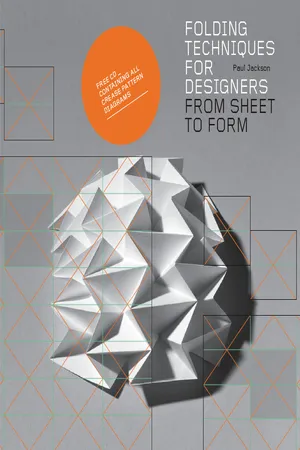
- 224 pages
- English
- ePUB (mobile friendly)
- Available on iOS & Android
eBook - ePub
About this book
Many designers use folding techniques in their work to make three-dimensional forms from two-dimensional sheets of fabric, cardboard, plastic, metal, and many other materials.
This unique book explains the key techniques of folding, such as pleated surfaces, curved folding, and crumpling. It has applications for architects, product designers, and jewelry and fashion designers
An elegant, practical handbook, Folding for Designers explains over 70 techniques explained with clear step-by-step drawings, crease pattern drawings, and specially commissioned photography.
All crease pattern drawings are available to view and download from the Laurence King website.
Frequently asked questions
Yes, you can cancel anytime from the Subscription tab in your account settings on the Perlego website. Your subscription will stay active until the end of your current billing period. Learn how to cancel your subscription.
No, books cannot be downloaded as external files, such as PDFs, for use outside of Perlego. However, you can download books within the Perlego app for offline reading on mobile or tablet. Learn more here.
Perlego offers two plans: Essential and Complete
- Essential is ideal for learners and professionals who enjoy exploring a wide range of subjects. Access the Essential Library with 800,000+ trusted titles and best-sellers across business, personal growth, and the humanities. Includes unlimited reading time and Standard Read Aloud voice.
- Complete: Perfect for advanced learners and researchers needing full, unrestricted access. Unlock 1.4M+ books across hundreds of subjects, including academic and specialized titles. The Complete Plan also includes advanced features like Premium Read Aloud and Research Assistant.
We are an online textbook subscription service, where you can get access to an entire online library for less than the price of a single book per month. With over 1 million books across 1000+ topics, we’ve got you covered! Learn more here.
Look out for the read-aloud symbol on your next book to see if you can listen to it. The read-aloud tool reads text aloud for you, highlighting the text as it is being read. You can pause it, speed it up and slow it down. Learn more here.
Yes! You can use the Perlego app on both iOS or Android devices to read anytime, anywhere — even offline. Perfect for commutes or when you’re on the go.
Please note we cannot support devices running on iOS 13 and Android 7 or earlier. Learn more about using the app.
Please note we cannot support devices running on iOS 13 and Android 7 or earlier. Learn more about using the app.
Yes, you can access Folding Techniques for Designers by Paul Jackson in PDF and/or ePUB format, as well as other popular books in Design & Product Design. We have over one million books available in our catalogue for you to explore.
Information


1.1.1 Linear Divisions into sixteenths
1. Basic Concepts
Basics are basics. What was basic yesterday will be basic tomorrow. Basics are the constants, the unchanging foundations upon which creative work can be built.
This chapter explains the basics of folding paper. The general concepts it introduces are the most important and the most useful in the book. Time spent learning them will be well rewarded when you progress to later chapters and when you create your own folded designs. If you are new to folding, or have only limited experience, you are encouraged to spend quality time with this chapter. However, do not just look at its contents – fold them!
Basic concepts are not only useful, but are also very adaptable. This is because they are necessarily generic and can thus be modified in an infinite number of ways. By contrast, ideas for folding which are more specific, are less adaptable. So, somewhat paradoxically, this is perhaps the book’s least showy chapter, but it also offers the most creativity. ‘Basic’ should not be mistaken for ‘uncreative’.
1.1. Dividing the Paper
Dividing paper into exactly equal lengths or angles enables many other techniques to be performed. The position of the folds can be marked with a ruler and pencil, but it is much quicker and much more accurate to make them by hand, dividing the paper into halves, then quarters, then eighths…and so on, using a simple and precise sequence of folds. It is the hand-made method that is explained here.
There is nothing inherently special about the sixteenths, thirty-seconds or sixty-fourths shown in this section, other than that they divide the paper many times and are easy divisions to explain. In your own work, it may be that you need to divide the paper into tenths, twenty-sixths, fifty-fourths, or whatever, in which case it is better to divide it into 16, 32 or 64 and then trim off the excess. Do not be a slave to the divisions shown here.
1.1.1. Linear Divisions: Sixteenths
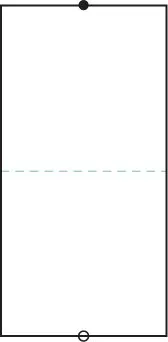
1.1.1 _ 1
Fold the o edge to the • edge, folding the paper in half. Open the paper.
Fold the o edge to the • edge, folding the paper in half. Open the paper.
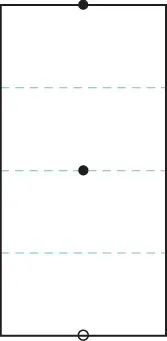
1.1.1 _ 2
Fold the edges to the centre line. Open the paper.
Fold the edges to the centre line. Open the paper.
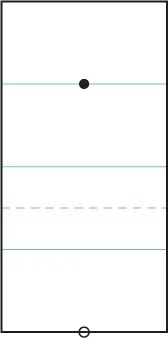
1.1.1 _ 3
Fold the o edge to the • crease. Open the paper.
Fold the o edge to the • crease. Open the paper.
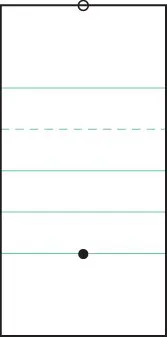
1.1.1 _ 4
Repeat Step 3 with the other edge.
Repeat Step 3 with the other edge.
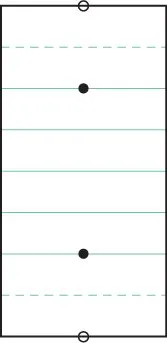
1.1.1 _ 5
Fold the o edges to the • creases. Open the paper.
Fold the o edges to the • creases. Open the paper.
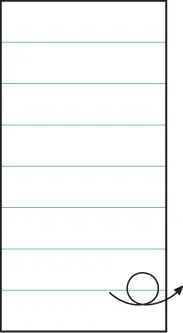
1.1.1 _ 6
There are now seven valley folds that divide the paper into equal eighths. Turn the paper over.
There are now seven valley folds that divide the paper into equal eighths. Turn the paper over.
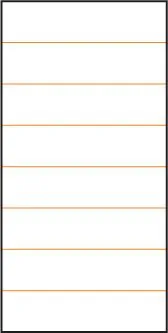
1.1.1 _ 7
There are now seven mountain folds.
There are now seven mountain folds.
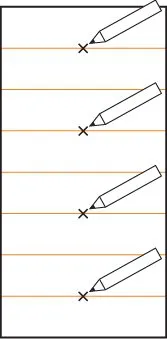
1.1.1 _ 8
With a pencil, discreetly mark each alternate mountain crease.
With a pencil, discreetly mark each alternate mountain crease.
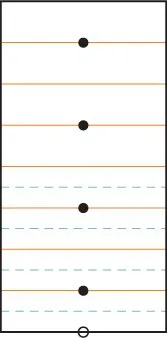
1.1.1 _ 9
Fold the o edge in turn to all the • creases marked in Step 8, making four new folds. Open the paper after each new fold.
Fold the o edge in turn to all the • creases marked in Step 8, making four new folds. Open the paper after each new fold.
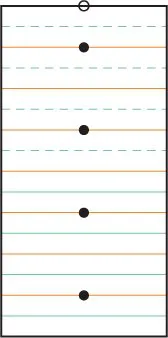
1.1.1 _ 10
Repeat Step 9 with the other edge of the paper.
Repeat Step 9 with the other edge of the paper.

1.1.1 _ 11
The paper is now divided into equal sixteenths, using creases which alternate mountain-valley-mountain-valley… across the paper (see photo on page 14).
The paper is now divided into equal sixteenths, using creases which alternate mountain-valley-mountain-valley… across the paper (see photo on page 14).
1.1.1 Linear Thirty-seconds

1.1.1 _ 1
Begin with Step 6 of the Linear Sixteenths method (see page 17). Using a pencil, discreetly mark each alternate valley crease.
Begin with Step 6 of the Linear Sixteenths method (see page 17). Using a pencil, discreetly mark each alternate valley crease.
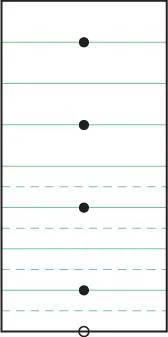
1.1.1 _ 2
Fold the o edge in turn to all the • creases marked in Step 1, making four new folds. Open the paper after each new fold.
Fold the o edge in turn to all the • creases marked in Step 1, making four new folds. Open the paper after each new fold.
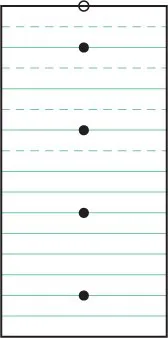
1.1.1 _ 3
Repeat Step 2 with the other edge of the paper.
Repeat Step 2 with the other edge of the paper.
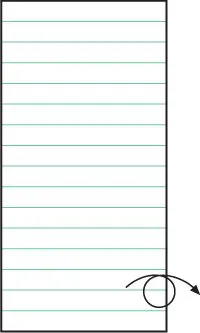
1.1.1 _ 4
There are now 15 valley folds. Turn the paper over.
There are now 15 valley folds. Turn the paper over.
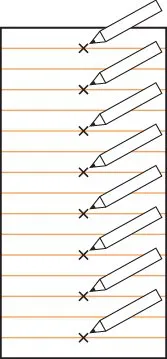
1.1.1 _ 5
With a pencil, discreetly mark each alternate mountain crease.
With a pencil, discreetly mark each alternate mountain crease.
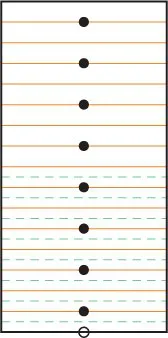
1.1.1 _ 6
Fold the o edge in turn to all the • creases marked in Step 5, making eight new folds. Open the paper after each new fold.
Fold the o edge in turn to all the • creases marked in Step 5, making eight new folds. Open the paper after each new fold.
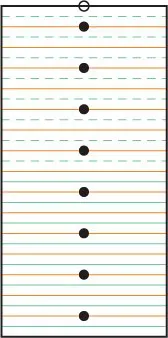
1.1.1 _ 7
Repeat Step 6 with the other edge of the paper.
Repeat Step 6 with the other edge of the paper.
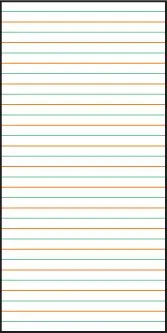
1.1.1 _ 8
The paper is now divided into equal thirty-seconds, using creases which alternate mountain-valley-mountain-valley (see photo opposite).
The paper is now divided into equal thirty-seconds, using creases which alternate mountain-valley-mountain-valley (see photo opposite).

1.1.1. Linear Sixty-fourths
To divide the paper into 64, fold up to Step 4 of the Linear Thirty-seconds method (see page 18). Then, instead of turning the paper over, continue on the same side, completing all the thirty-seconds as valley folds. Now turn the paper over. Mark the alternate mountain f...
Table of contents
- Cover
- Copyright
- Title Page
- Contents
- Preface
- 00. Symbols
- 01. Basic Concepts
- 02. Basic Pleats
- 03. Other Pleats
- 04. V-Pleats
- 05. Spans & Parabolas
- 06. Boxes & Bowls
- 07. No Crease, One Crease
- 08. Crumpling
- FAQs